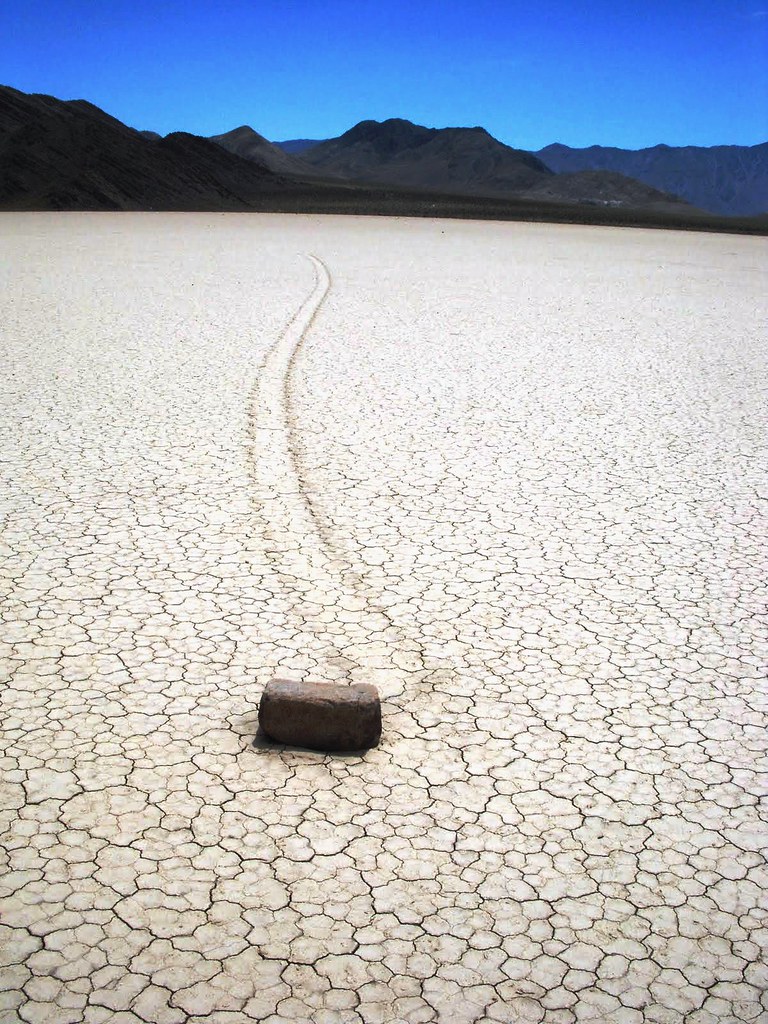I wanted to share some of the cool things I learned. After all, I feel like at least once in awhile I need to be true to the name of this blog and talk about the desert and what's in it. Plus, the more I learned about playas, the more I kept wanting to learn about playas. I've spent quite a bit of time doing some Internet searches the last few days. They are cool places, even though they are basically barren and hard to comprehend.
What is a playa? It's basically a dry lake bed. The word playa is Spanish for beach, which can be appropriate in some circumstances. G. K. Gilbert first used the word in a scientific context in 1875, while on a survey west of the 100th meridian. The word had already been in use by then, as Gilbert didn't define it. It's true that playas do get water on them. However, the evaporation rate is usually ten times greater than the evaporation rate. One other important component of playas is that they don't have an outlet. That means that the salts and other minerals that are left behind when the water evaporates are distributed evenly, creating a very flat, homogenous feature.
 How many playas are out there? Fox reports that more than 50,000 exist around the world. Most are small, like Yelland Dry Lake, pictured below.
How many playas are out there? Fox reports that more than 50,000 exist around the world. Most are small, like Yelland Dry Lake, pictured below. The largest playa in North America isn't far from where I live: the Great Salt Lake Desert. The largest playa in the world is Lake Eyre in Australia, with a surface area of about 3,600 square miles. That size is hard to comprehend!
If you don't have a playa near you, don't worry, as playas are growing in number and size. Okay, maybe that's not such a great thing. The reason they're growing is generally due to groundwater pumping.
The biggest example would be Owens Lake in California, which was a huge lake until the water feeding it was rerouted down a pipeline to Los Angeles. The resulting dry lake bed created some of the worst air pollution in the U.S.
 |
| Dust storm on east side of Owens Lake playa. Photo credit: Basin and Range Watch. |
If you want to find a sliver of a silver lining, it might be that humans have adapted to live with these playas in many ways. The following list is not in order of importance. At least to me. But perhaps it will be to you. Or maybe this list will give you some ideas about what you might want to do the next time you see a playa either in person or a photo.
1) First, playas are good for setting speed records. This is important to a lot of people as evidenced by the thousands that go to the Bonneville Salt Flats west of Salt Lake City every August.
 |
| A Streamliner at the 2009 Bonneville Salt Flat Races. (you can see a fun post I did looking at fast cars and going behind the scenes at the Bonneville Time Trials by clicking here.) |
 | |
|
 |
| From the Google Earth Blog: http://www.gearthblog.com/blog/archives/2011/09/burning_man_2011.html |
5) Playas have encouraged art of various types, such as the famous Nazca Lines in a desert in Peru.
 |
| From http://www.latinamericanstudies.org/nazca/nazca-lines.htm |
 |
| Ibex Hardpan |
7) Playas have some wonderful geologic mysteries contained in them, like the moving rocks on the Racetrack Playa in Death Valley National Park.
 |
| Photo credit: NASA/GSFC/Cynthia Cheung |
 |
| Photo credit: Blackrock at Backcountrypilot.org |
What's your favorite activity on a playa? My husband has wanted to build a sail-contraption, but fortunately hasn't gotten past the dreaming stage. Somehow crashing at high speeds on the high desert floor doesn't sound like much fun to me.
I'm going to try and pay a little more attention to playas.
Like sand dunes, they capture some of the essence of the desert: the dry, desolate, and forbidding places where life is harsh, if it exists at all.




.jpg)




















5 comments:
We made the trek to Racetrack Playa in Death Valley. Very, Very cool place!
Yes, the Racetrack is well worth the bumpy ride. Your "alien" looks a little familiar. gs
There is a playa/dry lake up north a ways in Spring Valley that makes for good arrowhead hunting. Apparently the indians there would catch fish by shooting them. They tend to be smallish arrowheads, but are often in exquisite condition.
Your first photo is a beautiful example of an inselberg buried up to it's neck in playa lake basin fill. Mind if I lift that photo as well?
John
Hi John, that's fine. This playa is easily accessible from Highway 50 next time you're up this way.
Post a Comment